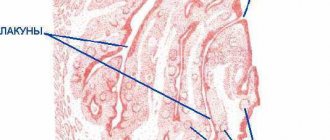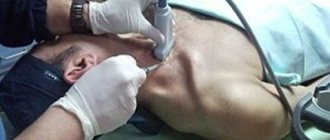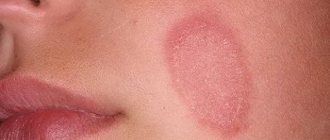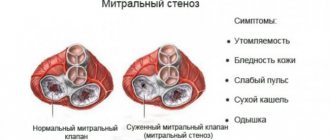Cardiac asthma is a condition of acute failure of the left heart, which is characterized by attacks of shortness of breath, suffocation and requires emergency medical care, since even precursors of asthma can be fatal. Insufficiency is expressed in a feeling of lack of oxygen, due to which the person begins to cough, wheeze, his face becomes cyanotic, diastolic pressure increases, and fear of death appears. An attack requires the use of urgent measures to help the patient with nitroglycerin, diuretics, oxygen therapy and other urgent actions. Cardiac asthma is not an independent disease. This is the name of a clinical syndrome that manifests itself with certain symptoms. Cardiologists consider cardiac asthma as the most severe manifestation of acute heart failure, which complicates other cardiovascular pathologies that a person has.
Causes
The causes of cardiac asthma can be any cardiac disease that results in heart failure.
Such diseases are:
- heart defects, most often mitral valve stenosis;
- cardiac ischemia;
- acute myocardial infarction;
- post-infarction cardiosclerosis;
- left ventricular aneurysm;
- arterial hypertension, hypertensive crisis;
- paroxysm of atrial fibrillation;
- myocarditis, post-myocardial cardiosclerosis;
- cardiomyopathy (hypertrophic, dilated, restrictive);
- intracardiac thrombi;
- heart tumor (myxoma);
- acute and chronic glomerulonephritis (due to the development of arterial hypertension).
Triggering factors that can provoke an increase in pressure in the pulmonary capillaries are excessive psycho-emotional or physical stress in patients with the listed diseases. Also, episodes of cardiac asthma can appear during pregnancy against the background of existing cardiac diseases, or with fever in patients with chronic heart failure.
Trigger factors
An asthma attack is always triggered by trigger factors.
Among them:
- Allergic reaction. Provokes an immune response, increased cardiac activity. Intensification of the heart's work results in a violation of blood emission. Then everything is clear.
- Binge eating. Patients with heart pathologies should not eat heavily at all.
- Long-term immobilization. The heart does not receive adequate load and begins to work more slowly. Myocardial contractility is normal, but the intensity of blood emission decreases. This is a temporary phenomenon. It subsides upon returning to a normal lifestyle.
- Parenteral administration of drugs in large quantities. Increases the volume of fluid in the body, and hence the load on the kidneys.
Adjustable trigger factors:
- Abuse of salt the day before.
- Too much liquid. It is not recommended to drink more than two liters per day. Hypertension and heart patients have even less.
- Alcohol consumption.
- Smoking. The phenomena occur after several puffs.
- Stressful situation.
- Excessive physical activity.
Symptoms
Precursors of an attack of cardiac asthma can be: shortness of breath, tightness in the chest, coughing during slight physical activity or moving to a horizontal position that has appeared in the previous 2-3 days. Attacks of cardiac asthma are more often observed at night, during sleep, due to a weakening of adrenergic regulation and an increase in blood flow into the pulmonary circulation system in the supine position. During the daytime, an attack of cardiac asthma is usually associated with physical or neuropsychic stress. Typically, attacks of cardiac asthma occur suddenly, causing the patient to wake up from a feeling of acute lack of air and increasing shortness of breath, turning into suffocation and accompanied by a hacking dry cough (later with a small separation of clear sputum). During an attack of cardiac asthma, it is difficult for the patient to lie down; he takes a forced vertical position: stands up or sits down in bed with his legs down (orthopnea); usually breathes through his mouth, speaks with difficulty. The state of a patient with cardiac asthma is excited, restless, accompanied by a feeling of panicky fear of death. On examination, cyanosis is observed in the area of the nasolabial triangle and nail phalanges, tachycardia, and increased diastolic blood pressure. On auscultation, dry or scanty small bubbling rales may be noted, mainly in the lower parts of the lungs. With a prolonged and severe attack of cardiac ascyanosis, cold sweat, swelling of the neck veins; the pulse becomes threadlike, blood pressure drops, and the patient feels a sharp loss of strength. The transformation of cardiac asthma into alveolar pulmonary edema can occur suddenly or as the severity of the disease increases, as evidenced by the appearance of copious frothy sputum mixed with blood, moist small- and medium-bubble rales over the entire surface of the lungs, and severe orthopnea.
Prevention
As already mentioned, cardiac asthma is not an independent diagnosis, but a complication of many heart diseases. In the vast majority of cases, the patient knows about his illnesses, but not everyone receives adequate treatment, and often this is the fault of the patient himself (“too many pills, I won’t take them,” “I’m afraid of surgery,” etc.)
Important Gargling with soda and salt during pregnancy
However, having experienced at least one attack of cardiac asthma, people begin to fear its recurrence, are afraid of suffocation and begin to listen to the advice of doctors.
Lifestyle recommendations
- Do not overwork, observe the work and rest schedule. Vigorous physical activity is usually not contraindicated. It is worth taking a walk every day; walks are especially good before bed. Sleep should be at least 8 hours a day.
- Quit alcohol and smoking.
- You should sleep with your head elevated.
- Avoid stress and nervous tension. It will not be possible to get away from this completely, but some foreseeable situations can be avoided. Particularly sensitive people can take sedatives (only as prescribed by a doctor).
- Avoid hypothermia and acute respiratory infections, get vaccinated against the flu.
Dietary recommendations
- Food should be easily digestible, with limited animal fats.
- The main cooking options are boiling, stewing or baking.
- Limit table salt consumption to 5 g per day. It is usually recommended to cook food without salt, and then add salt, spreading this amount (about a coffee spoon) over the whole day.
- If you are overweight, you should reduce calories and portion sizes. It is necessary to lose weight, this is a very important point in the treatment of heart disease.
- Consume no more than 1.5 liters of liquids per day.
- Have dinner no later than 2-3 hours before bedtime.
What needs to be done to prevent the attack from happening again?
- Complete all prescribed examinations to accurately establish a diagnosis or clarify the stage of the disease.
- When a diagnosis is made, take all medications prescribed by your cardiologist. Doses must be adjusted under the supervision of a doctor, and not canceled or reduced independently.
- Monitor your blood pressure and pulse regularly.
- In case of valve disease, surgery is indicated and consultation with a cardiac surgeon is necessary.
Treatment
In case of emergency, you need to call an ambulance. When the team arrives, the patient should be seated by the window, ensuring air flow. Emergency care for cardiac asthma includes applying tourniquets to the limbs, 10 minutes after the patient has assumed a sitting position. When providing emergency care for cardiac asthma, it is important to control the blood pressure of the patient sick. If it is normal or increased, then the patient is given a tablet of nitroglycerin or nifedipine under the tongue. Since cardiac asthma is a secondary disease, the course of treatment should be aimed at eliminating the underlying disease. The doctor determines the patient's proper activity regimen. A diet and level of acceptable physical activity are prescribed. Depending on the causes of coughing and choking, various drugs are used, administered by injection. For severe shortness of breath, pain, and signs of pulmonary edema, narcotic analgesics are used, including morphine (1%). Oxygen inhalations and intravenous injections of ethyl alcohol also have a good effect. Diuretics are prescribed intravenously (furosemide 2-8 ml). It is advisable to use cardiac glycoside preparations. They are especially effective in the presence of tachycardia. During the provision of medical care, the patient's blood pressure is constantly monitored.
Cardiac asthma: can it be prevented?
Cardiac asthma manifests itself in the form of attacks of suffocation and shortness of breath caused by left ventricular failure. This leads to stagnation of blood in the pulmonary circulation. Blood plasma penetrates the bronchi and lung tissue, causing pulmonary edema and causing suffocation and difficulty breathing. This pathology requires emergency medical care; if the attack is not stopped quickly, it can be fatal.
Anatomy of the heart and blood circulation in the lungs
Heart of three layers
- Endocardium is the inner layer. It is formed from endothelium, a special, smooth connective tissue that prevents blood clots from attaching to the walls of the heart.
- Myocardium is the middle layer. The muscle layer that causes the heart to contract. Thanks to the special structure of muscle cells (cardiomyocytes), the heart works without stopping. In the atria, the muscular layer is two-layered, and in the ventricles it is three-layered, since they need to contract harder to push blood into the arteries.
- The epicardium is the outer layer. The outer shell is made of connective tissue that protects the heart and prevents it from expanding too much. The heart is divided into two halves by a septum. Each of which consists of an atrium and a ventricle. First, the atria contract simultaneously, pushing blood into the ventricles. Contraction of the ventricles occurs after some time. They send a portion of blood into the arteries.
- The right half of the heart is called the venous half. The right atrium receives blood from all organs. Its oxygen content is low. After the atrium contracts, a portion of blood enters the ventricle. From the right ventricle, blood enters an artery called the pulmonary trunk. This vessel carries blood to the lungs, where it is enriched with oxygen. Between the right atrium and the right ventricle is the tricuspid valve. It ensures blood flows in one direction.
- The left half of the heart is arterial. The left atrium receives blood from the pulmonary veins. It enters the left ventricle, and from there into the largest artery, the aorta. Further, oxygen-enriched blood is distributed throughout the body, ensuring the breathing of all organs. In the left half, between the atrium and the ventricle, there is a bicuspid or mitral valve, which prevents the backflow of blood from the lower parts of the heart.
Important Bronchipret TP tablets: instructions for use, reviews
Light functions
- Thermoregulation. When breathing, the body cools due to the release of steam.
- Protects the heart from beating.
- Bronchial secretions contain immunoglobulin-A, as well as mucin, lysozyme, and lactoferin to protect against infections. The ciliated epithelium of the bronchi removes dust particles and bacteria.
- Provide airflow to create voice.
Structure of the lungs. Innervation of the lungs. Features of the blood circulation of the lungs (pulmonary circulation). pulmonary trunk. Mechanism of edema of the lung tissue.










